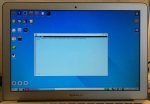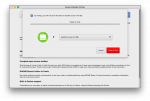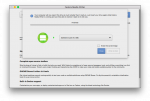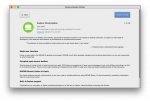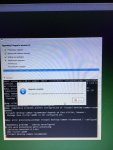Trisquel 8 codename "Flidas" Release Candidate is ready for testing
- Inicie sesión o regístrese para enviar comentarios
Hi all!
Trisquel 8 is almost ready, and we've got a full set of Release Candidate ISO images for testing at http://jenkins.trisquel.info/makeiso/iso/RC/
These latest images should have fixed all the issues some of us had with bootable USB drives and untimely initramfs prompts. They also include of course all the recent functional and freedom fixes and the new artwork.
If no release-blocking bugs (i.e., something that renders these images unusable for someone or new freedom issues) are found, we'll proceed with the release on Monday 16. That gives us a full week for testing and feedback and also for fixing an small but relevant issue I'll write about below.
Please test these images for those release-blocking bugs and have in mind that we'll try to work on the rest of the old and new non-critical pending issues right after the public release. We'll also share our plan for the soon-to-be started Trisquel 9 development with the Flidas announcement.
One issue that we'll be fixing this week is the implementation of proper translation hooks for the new Abrowser homepage privacy settings. We'll also include some translations (it's currently only available in English) with the help of several community members, and we'll share the details for adding more languages to this increasingly relevant component later.
Thanks all for your help!
That's great news.
Is there a document or URL that you could point us to that gives instructions on how to capture upgrade/install output?
I know about /var/log/dist-upgrade, but how would we capture the terminal output during the upgrade/install? Or is that not valuable?
And any other suggestions would be helpful.
Thanks.
> how would we capture the
> terminal output during the upgrade/install?
If I understand your question correctly, you can write the output of a terminal command to a file with '>'.
$ the-command > the-file.log
or in the case of your question,
$ sudo apt upgrade > upgrade.log
> $ sudo apt upgrade > upgrade.log
Actually, never mind. If you do this the output won't be printed to the terminal, so you won't be prompted to confirm that you want to upgrade packages. Instead use
$ sudo apt upgrade | tee upgrade.log
which will both print the output to the terminal and write to the file.
Beautiful!
I Googled "tee" before my post, but I wasn't sure if it would work with a terminal session like this.
Thanks!
When trying to open the file "trisquel_8.0_amd64.iso.torrent" in Transmission, I get the error: "Tracker gave an error: "Requested download is not authorized for use with this tracker"."
Yeah, the torrents never work on the development versions.
I found a couple smaller bugs. One is a typo, and another relates to the spell checker/dictionary in Abrowser.
What's the most appropriate way of reporting these bugs?
> What's the most appropriate way of reporting these bugs?
Hi david, thanks! This is what I'm waiting for.
Given that Trisquel, like its Ubuntu base, is meant to be the most user-friendly distro for people new to GNU-Linux, what are the recommended methods for installing Trisquel for people currently using:
* Windows
* Mac
* Ubuntu
Is there any kind of 'introducing Trisquel' wiki page or document that we can distribute to people, encouraging them to try it for the first time, and supplying these installation instructions? If so, will it need to be updated for Trisquel 8?
We have those manuals: https://trisquel.info/en/wiki/installation-guide
Checking whether the instructions still work (if not, correcting them) would be nice. In particular, the last update on https://trisquel.info/en/wiki/install-trisquel-windows-dual-boot-0 is almost five years old.
But that requires having at hand an installed Windows/Mac/Ubuntu system, what many of us have not.
My wife has a Mac (running El Capitan), which I can use (with her permission) to test the MacOS instructions. We no longer own any devices running Windows (yay!), but I'm sure there are GNUbies out there who still have a dual-boot, or run Windows on a separate PC. Anybody willing to do some testing and help update the wiki if needed? It would be good to make sure the instructions work for 2000/XP, Vista/7, and 8/10, with separate instructions for different versions if needed.
Burning .ISO to CD
I note that the code of Infrarecorder, the app recommended for burning the .ISO on Windows, doesn't appear to have been worked on since 2012 according to its GitHub repo:
https://github.com/kindahl/infrarecorder
There is a FOSSHub page last updated in 2014, which suggests it worked then on all Windows versions from 2000 > 8:
https://www.fosshub.com/InfraRecorder.html/
Similarly, the Burn app recommended for burning the .ISO on MacOS hasn't had a new version released since 2011, and I could fine no sign of the developer moving it to another forge:
(https://sourceforge.net/projects/burn-osx/files/)
Since the goal is to help a user transition to a fully free OS from an OS they're already running, why not simply give instructions for using the default disc burning software in that OS (per version if they differ)? Or if there isn't one, the most common disc burning freeware for that OS? That way the instructions are more likely to stay up-to-date, regardless of the fortunes of free code Windows/ Mac apps.
Making Bootable USB
The Windows instructions for making a bootable USB recommend the Universal USB Installer from PenDriveLinux. According to the homepage for that program, it now requires Vista or higher to work:
"Windows Vista/7/8/10 or WINE to create the USB (Win 98/XP/2K WILL NOT Work!)"
http://www.pendrivelinux.com/universal-usb-installer-easy-as-1-2-3/#button
The devices running these older version are more likely to have a CD-ROM drive, and also more likely not to have a BIOS that allows booting from USB. It might be good to include a note under the 'Boot Media' section of the Installation Guide page, advising people running these older versions of Windows that the USB method may not work, and recommending they install by burning a CD.
Windows 10 burning an image is easy. Just open Explorer, right-click on the ISO and select 'Burn disc image'. Pix to follow if somebody needs them to write up instructions.
Software dos not necessarily stop working because it is old. If there is usable free software to install the live ISO, let us recommend that! We value freedom over convenience.
MagicBanana:
>> Software dos not necessarily stop working because it is old. <<
True, but you have to admit it sometimes does cause problems, due to changes made to the OS (eg by security patches) since the last time the program was worked on, or users trying to use it on a newer version of the OS released since development stopped.
>> If there is usable free software to install the live ISO, let us recommend that! We value freedom over convenience. <<
Very well, how about we change the instructions to recommend Etcher, which I just found this thanks to an article on MakeUseOf:
https://www.makeuseof.com/tag/how-to-boot-a-linux-live-usb-stick-on-your-mac/
Etcher can burn images to both optical discs and USBs. It's licensed Apache 2.0, and has versions for MacOS, and 32-bit and 64-bit versions for both GNU-Linux and Windows. Last commit when I looked just now was 19 hours ago:
https://github.com/resin-io/etcher
I wonder if Red Hat's Fedora Media Writer could be modified to download and write Trisquel ISO to USB. It's available for Win/Mac/Linux.
https://getfedora.org/en/workstation/download/
I'm guessing that modifying Fedora Media Writer, to make it work with Debian-based systems and burn distros other than Fedora, is probably more work than forking Etcher and removing the offending behaviour. Don't let me discourage you though, if that's your itch, you go ahead and scratch it! :)
Sorry to be blunt, but that's plain wrong. It has no rpm dependencies.
It writes any ISO.
Just select "custom image" and pick a file from your drive. The only part that would be changed is the automatic download which points to Fedora.
I think it would be easy to make it point to Trisquel instead of Fedora.
I have no discomfort using dd and wget or any other CLI. The added advantage would be to make it seamless. Click, download and burn! For those GUI lovers and busy people who are interested in Trisquel but are intimidated by the command line or haphazard instructions.
https://trisquel.info/en/forum/user-respect-issues-etcher#comment-130518
Loldier wrote:
"[Fedora Media Writer] writes any ISO."
My apologies, you are of course correct. I skim read the first of the links you shared, and got the impression that the instructions given there was the limit of what the program could do. Now that I look again, the images make it clear that impression was, as you say, quite incorrect:
https://developers.redhat.com/blog/2016/04/26/fedora-media-writer-the-fastest-way-to-create-live-usb-boot-media/
It would be interesting to see what libraries and other dependencies FMW is using under the hood, and how they compare to those used by Etcher. I will suggest to The Assassin that we have at least a cursory glance at the FMW code (as well as the UNetbootin code) as part of creating our fork of Etcher. Perhaps forking an app other than Etcher might be easier or better, or perhaps we can hybridize the best elements of multiple programs.
If it is free software and more user-friendly than "Burn", then it is indeed a good idea.
It might also be good to have a wiki page on some of the common problems people run into when trying to create and use bootable USBs. For example, I flashed both main and Trisquel-Mini versions of Flidas onto an old 4GB USB with Etcher. Trisquel-Mini worked initially, but failed during the process of booting the live session. Trisquel main got to the live session, but then I ran into some problems with web pages crashing.
I'm currently trying to figure out whether the problem is the USB being too old to work reliably, but the Disks benchmark failed (in Belenos) due to a well-know bug, and I'm struggling to find any other way to test the health of the USB that isn't super complicated. Here is the best advice I've found so far, after an hour or so of web searching and skimming:
https://superuser.com/questions/376274/how-to-check-the-physical-health-of-a-usb-stick-in-linux
I'm going to test the same USB with a different burning method, and see if that makes any difference. If it works fine with Startup Disc Creator or DD, that points to the problem being Etcher, which would be good to know.
"Given that Trisquel, like its Ubuntu base, is meant to be the most user-friendly distro for people new to GNU-Linux,"
I would say Trisquel is meant to be the most user-friendly distro that is fully free. That last clause matters a lot, since there are other distros that put user-friendliness (defined by ease of use rather than respecting the user's freedom and privacy) above all other considerations.
One benefit of using MATE is that it should be fairly easy to shift the look and feel of the user interface to match what users accustomed to other OSes expect. The default of course strongly resembles Windows, especially Windows 95 through Vista. MATE (at least the version in Ubuntu MATE) has a "Panels" dropmenu in the MATE Tweak tool's "Interface" portion that lets you switch to a Mac-like look and feel ("Cupertino") or Ubuntu-style ("Mutiny"). Does Trisquel 8's implementation of MATE have this? I would also recommend a "Mountain View" option that replicates the ChromeOS or Chromium OS look and feel.
What’s up with this devel not found? I get this when attempting to initiate a download from the RC link.
http://jenkins.trisquel.info/makeiso/iso
...works as always
I'm also getting a weird issue with downloading trisquel_8.0_i686.iso from:
http://jenkins.trisquel.info/makeiso/iso/RC/
I've tried it twice, and both times, it almost downloaded, then displayed an error in the ABrowser downloads menu, saying "file moved or missing". I haven't moved the file, and it's not missing, there's a 2.6GB file with that name in my Downloads folder. But running md5sum on that file gives me a hash that doesn't match the md5sum file downloaded from the same source.
I have almost 90GB free on my drive, so that's not the problem. I'm mystified. Could it be that too many of us are hitting that server, causing downloads to fail? Is there another download source I could try?
What's really strange is that I successfully downloaded the Sugar edition from the same source, and the download completed and passed the md5sum just fine. I made a bootable USB with the Startup Disc Creator in System Settings, and booted into a live system just fine too (first time I've managed to get a Sugar DE working, yay!).
I downloaded the 64-bit version from Jenkins.trisquel.info/makeiso/RC/ and wrote it to flash drive using the 'dd' command; resulting image is not bootable. I used http in the browser, which works for all other distros' live images but Trisquel.
Since my last post, I managed to get a bootable system by extracting the .iso archive onto a formatted flash drive, having one FAT partition, taking up the whole disk. Once I booted this version, I tried running the screen reader, and got it started, only to have it turn off within 5 seconds, or so. I tried using the toggle shortcut, 'alt+super+s' and by using the 'run' dialogue and typing "orca", then hitting 'enter'. I tried several reboots, waiting different amounts of time before starting orca, perhaps the desktop wasn't ready? Still no joy. Is anyone else using orca on this edition?
Success! Today I:
* used wget to download trisquel_8.0_i686.iso - check!
* checked the md5sum - check!
* used Startup Disk Creator in Belenos to create a bootable USB - check!
* rebooted using the USB - check!
* checked the integrity of the USB - check!
* rebooted and launched a live session using the USB - check!
* connected to WiFi - check!
* logged in here and posted this message - check!
At times, I have worried that I wouldn't be able to run Flidas on my poor old Aspire One, and that I'd have to fall back to Trisquel-Mini, or maybe abandon Trisquel for a more lightweight distro. I'm happy to report Flidas works like a dream with the new Mate DE, and I'll be staying with standard Trisquel!
Next I will try installing to my test partition. I will also test making a T8 USB using my wife's MacOS, following the instructions on the wiki, and try booting into Trisquel on her Mac too. I'll also download Trisquel-Mini and test that. Will report back on the results.
Just tried using the Flidas USB I successfully used on my AA1 to boot up a live session on my wife's Mac (El Capitan). No dice. I held down the Option key, and got a screen allowing me to choose boot sources, but it didn't pick up the OS on the USB.
Do I have to use a live USB *made* on a Mac to boot up on a Mac? Any suggestions?
Trisquel 8 doesn't boot on my mac. Burned an ISO to DVD using Finder's built-in burner. All is fine but the disc won't show up at boot. It is mounted and recognized on the desktop alright.
At the same time, Debian 9 and Puppy Xenialpup boot just fine. They show up as "EFI boot".
rEFInd finds the disc but it's "legacy boot" and won't budge.
I have a 2015 Macbook Air.
##EDIT##
Ubuntu has instructions on creating a bootable USB stick on a mac. It involves using Etcher. I don't know if they are valid.
https://tutorials.ubuntu.com/tutorial/tutorial-create-a-usb-stick-on-macos
OK, so at least two of us have access to Macs for testing (my wife's is an older MacBook - about 7-8 years old), that's great. It would be great to come up with a fairly reliable set of instructions for installing Flidas on Macs. Shall we start a separate thread to focus on this?
I'd love to contribute; just don't see how it's feasible. I've tried Trisquel on macs many times in the past and now with the latest ISO. Etcher is no magic silver bullet. It's always been like this. I was hoping to replace Mint on my Macbook Air with T8 but now I've given up hope.
DD, my personal favourite, or any other program is capable of writing the ISO to disk but they won't show up in mac's Boot Manager. rEFInd shows it as "legacy boot" and prompts for "updated firmware" whatever that is (Open Firmware?).
There's something awry in Trisquel's UEFI/EFI implementation that mac's boot firmware doesn't recognize as bootable.
I'm on a live session, booted from a USB stick written on my Macbook Air (Sierra) with Etcher. It works on this HP but on my mac no cigar.
By the way, I don't find Etcher's opt-out of sending "user statistics" funny. They also have "in-app purchases" (they promote hardware EtcherPRO). We shouldn't condone such behaviour. I'd go with diskutil and dd (CLI) or Finder's Burn plugin (GUI) for macs.
##Addendum##
Fedora Media Writer works nicely -- with Fedora. I sure wish it would be this easy to download and write ISO to a USB stick.
There's a lot that could be said on both the topics in this comment.
I've started a new thread to discuss Mac-specific problems with Trisquel here:
https://trisquel.info/en/forum/getting-trisquel-8-working-macs
I've also started a new thread on the user respect issues with Etcher here:
https://trisquel.info/en/forum/user-respect-issues-etcher
Is there a way to download images, checksums, etc of Trisquel 8 over https? For now, all the links are plain, unencrypted http
... Does anyone know why my upgrade from Trisquel 7 to 8 is failing?
Have you rebooted in the system? It looks like only one package, libclutter-imcontext-0.1-bin, raised an issue and, as a consequence, only the keyboard input method IBus (typically for Asiatic languages), which depends on it, would not work. That should not prevent you from getting a working desktop from which you can try to understand and fix the issue.
Thanks Magic. I appreciate your response.
Booting back in works fine. But I feel like some things may be semi-broken if the installer says it could not complete... I will update this thread with pictures of the behavior I find post reboot.
=== OTHER SEMI-RELATED ISSUE ===
By the way, on my other Trisquel laptop, a Macbook Pro 17inch from mid-2010, I installed Ubuntu 14.04 (to get EFI booting on a Mac), then I Triquelized it and then tried to upgrade to Trisquel 8. There were issues. I rebooted and the Trisquel 8 GUI seemed to have issues like no spacing between menu items and the try icons are very large. I will add screenshots of my experience with this in another thread. I was just wondering if you have a sense of what may be happening. Are there any expected issues with upgrading from a Trisquelized system?
=== OTHER SEMI-RELATED ISSUE ===
Magic Banana, after rebooting the system shows a black screen and won't allow me to login at all :/
Does Ctrl+Alt+F1 allow you to log in a text session?
Yes it does! However apt is broken and even using wget to install packages that may be missing doesn't acknowledge the pkg files as being installable. :/
Currently I am attempting to clean out my packages that arent in the trisquel repo and see if that works.
I'm using apt-show-versions | grep 'No available' to find whats not in the trisquel repo.
I think ill need to delete JUST the packages in the list that comes up and not the dependencies to them... I need to figure out how to do that.
To be honest, with a broken package manager, the fastest path to a working system is probably through a fresh install from the ISO (specify the partition for /home but do not format it!). Of course you want to backup the user data first... but you have probably already done that, right? If not, you can do so from the text session with 'cp -a' and an external disk.
You may want as well to save some customized system configuration, in /etc, and maybe the list of installed packages (to then easily more easily request their installation, either with 'sudo dpkg --set-selections < file' and 'sudo apt-get -u dselect-upgrade', or using the menu "File/Read markings..." of the "Synaptic Package Manager"):
$ sudo dpkg --get-selections > file
I just fixed it. :D
In the past I always just shrugged and said, you know what, I'll just do a clean install... However, this time I decided I try to figure this out. It turns out the main issue my upgrade wasn't working was because I had lots of packages that were from non-trisquel repositories. When I installed apps from some repository or ppa, some things the upgrader wasn't expecting were being included. I think in hindsight it may have been the fact I had 3 versions of gcc installed (versions 5, 6 and 7). This is how I fixed everything:
1) Remove all non-trisquel PPAs and repositories from the Software & Updates app.
2) Do the folloiw ing the terminal:
$ sudo apt install apt-show-versions
$ sudo apt-show-versions | grep 'No available'
This shows a list of packages I have installed that aren't from a repository on my system.
3) Purge packages that are on the list using the following command:
$ sudo dpkg -P --force-all <1st-package-to-purge> <2nd-package-to-purge>
This command removes the package without removing dependencies, which is what is needed here.
4) I rebooted noticed that I got a notification in my tool bar that many packages were now broken, so I went to Synaptic Package manager and it told me that stuff was too broken so I closed that program and went back to the terminal and typed the following command:
$ sudo aptitude -f install
Aptitude then suggested a dependency fix which was aggressive but worked. I just hit "Y" to proceed.
5) Then I typed the following commands to make sure thatI didn't remove anything that Trisquel needed:
$ sudo apt-get autoremove
$ sudo apt-get autoclean
$ sudo apt install trisquel
I noticed that aptitudes "fix" removed the trisquel package so I installed it again.
6) I rebooted and did one last autoremove, autoclean, update and upgrade. Then typed the following commands to get the upgrade to Trisquel 8 going:
$ sudo apt install upgrade-manager
$ sudo upgrade-manager -d
At this point the GUI upgrader boots and I just went through the prompts saying "Yes" and "OK" to everything. I selected "Restart" at the end of the upgrade and I computer booted just fine!
I think this technique could help a lot of people who are having issues upgrading.
By the way, I only felt comfortable experimenting like this because I had made a disk image backup with Clonezilla to make sure I could restore my OS if I broke it while experimenting.
'ppa-purge', in Trisquel's repository, is supposed to ease what you have just done. The PPA must still be enabled to "purge" it. It can then be removed and the packages it provides can be erased (one can use the "Origin" button of the "Synaptic Package Manager").
I was in the exact same situation: with several versions of gcc/g++ installed from a PPA, the same as you I believe. I realized it could be problematic for the upgrade to Trisquel 8. After a backup of the user data, I therefore did what I have just written in the paragraph above. It apparently all went well: I shut the system down. The day after was supposed to be the day I would *upgrade* to Trisquel 8... but, for some reason, Trisquel 7 did not start: a black screen with not even an access to a text session. I did a fresh install...
The thing is I wasn't sure if ppa-purge would just remove the exact package while leaving the dependencies alone. That's why I didn't use it. I'm just happy I didn't have to wipe my system for the 20th time. I'm very thankful for being able to access all of this information on the web and getting help from knowledgeable people such as yourself to help me get through this. Thanks very much.
Hello
I din't have any problems installing Trisquel 8 mini i686.iso in a netbook atom N280.
checksum md5 ok, live image done with "creador de discos de arranque" in USB ok, booting and installing ok.
Success installing Trisquel 8 amd64.iso on a desktop ASUS/Intel.
Some problems whith BIOS, now is booting as a... UEFI OS?
Libre greetings
"now is booting as a... UEFI OS?"
Yup. Trisquel 8 should be fully UEFI compatible. Yay! With the exception of Secure Boot, which requires Microsoft to sign stuff for the project so it can be trusted. Our fearless leader said on IRC that that's not gonna happen. No kowtowing to Microsoft.
Don't you mean Restricted Boot?
Yeah, it should be restricted not 'secure'. When they say 'security', always ask "whose security?"
https://www.fsf.org/campaigns/secure-boot-vs-restricted-boot
To both onpon4 and lolider, No I did mean Secure Boot. In a Secure Boot environment the user gets to decide what keys the computer treats as trusted or not. Restricted Boot describes a different setup where they can't.
The FSF even draws this distinction: "When done correctly, 'Secure Boot' is designed to protect against malware by preventing computers from loading unauthorized binary programs when booting. In practice, this means that computers implementing it won't boot unauthorized operating systems -- including initially authorized systems that have been modified without being re-approved. This could be a feature deserving of the name, as long as the user is able to authorize the programs she wants to use, so she can run free software written and modified by herself or people she trusts."
In that they're describing Secure Boot, not Restricted Boot.
So we can use both terms (Secure Boot and Restricted Boot) depending on the specifics of the situation. And in this case I was talking of Secure Boot.
- Inicie sesión o regístrese para enviar comentarios



